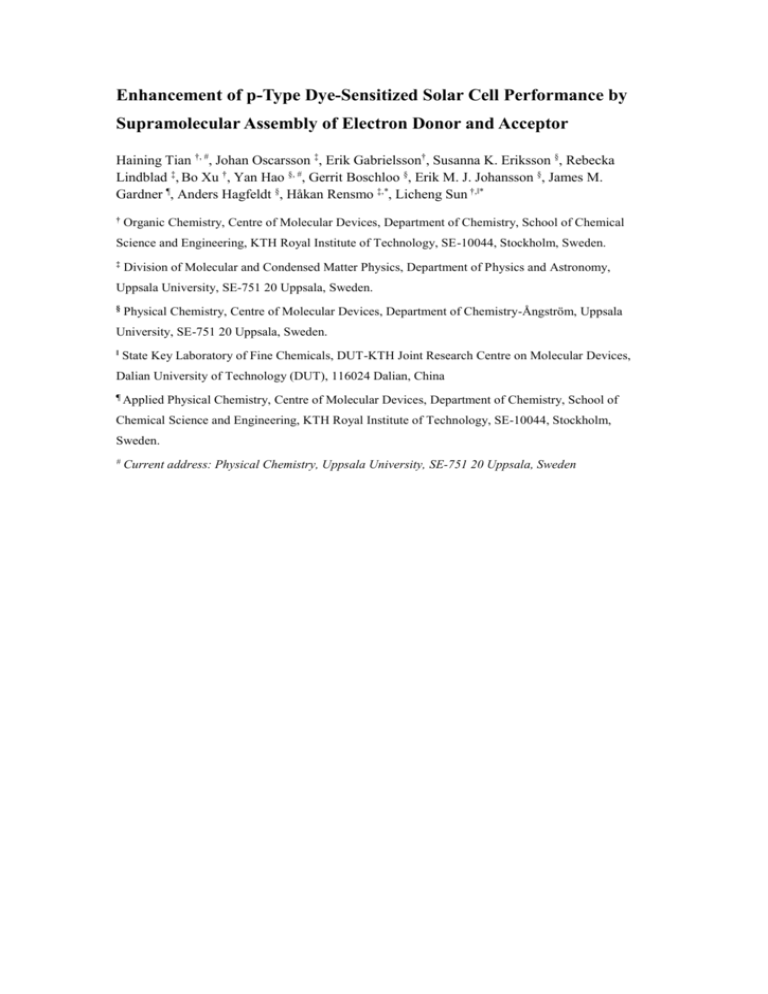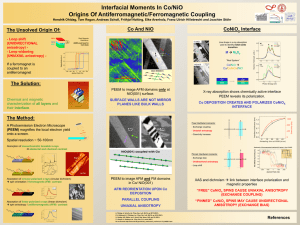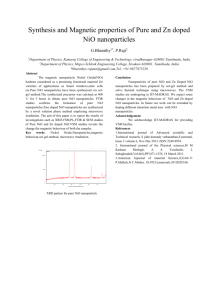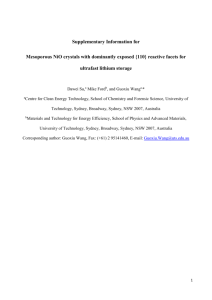srep04282-s1
advertisement

Enhancement of p-Type Dye-Sensitized Solar Cell Performance by Supramolecular Assembly of Electron Donor and Acceptor Haining Tian †, #, Johan Oscarsson ‡, Erik Gabrielsson†, Susanna K. Eriksson §, Rebecka Lindblad ‡, Bo Xu †, Yan Hao §, #, Gerrit Boschloo §, Erik M. J. Johansson §, James M. Gardner ¶, Anders Hagfeldt §, Håkan Rensmo ‡,*, Licheng Sun †,‖* † Organic Chemistry, Centre of Molecular Devices, Department of Chemistry, School of Chemical Science and Engineering, KTH Royal Institute of Technology, SE-10044, Stockholm, Sweden. ‡ Division of Molecular and Condensed Matter Physics, Department of Physics and Astronomy, Uppsala University, SE-751 20 Uppsala, Sweden. § Physical Chemistry, Centre of Molecular Devices, Department of Chemistry-Ångström, Uppsala University, SE-751 20 Uppsala, Sweden. ‖ State Key Laboratory of Fine Chemicals, DUT-KTH Joint Research Centre on Molecular Devices, Dalian University of Technology (DUT), 116024 Dalian, China ¶ Applied Physical Chemistry, Centre of Molecular Devices, Department of Chemistry, School of Chemical Science and Engineering, KTH Royal Institute of Technology, SE-10044, Stockholm, Sweden. # Current address: Physical Chemistry, Uppsala University, SE-751 20 Uppsala, Sweden Figure S1. The H1-NMR spectrum of ZnTCPP Figure S2. The H1-NMR spectrum of C60PPy Absorbance C60PPy in toluene 400 500 600 700 800 Wavelength [nm] Figure S3. UV-Vis spectrum of C60PPy in toluene Figure S4. Absorbance spectrum of C60PPy on NiO (NiO as background). Figure S5. Absorbance spectra of NiO sensitized by ZnTCPP(a) and TCPP(b). 40 NiO NiO/C60PPy NiO/ZnTCPP NiO/(ZnTCPP/C60PPy) 35 IPCE [%] 30 25 20 15 10 5 0 400 500 600 Wavelength [nm] 700 800 Figure S6. IPCE spectra of NiO, NiO/C60PPy, ZnTCPP and ZnTCPP/C60PPy-based p-type DSCs TCPP TCPP/C60PPy -2 Photocurrent Density [mA.cm ] 1.2 0.8 0.4 0.0 0.00 0.03 0.06 0.09 Photovoltage [V] 0.12 0.15 Figure S7. J-V curves of TCPP and TCPP/C60PPy-based p-type DSCs 30 TCPP TCPP/C60PPy 25 IPCE % 20 15 10 5 0 400 500 600 Wavelength [nm] 700 800 Figure S8. IPCE spectra of TCPP and TCPP/C60PPy-based p-type DSCs 1.2 ZnTCPP ZnTCPP+C60PPy Absorbance 1.0 0.8 0.6 0.4 0.2 415 420 425 430 435 440 445 Wavelength [nm] Figure S9. The absorption spectra of ZnTCPP with/without C60PPy in Tol:EtOH (10:1) Table S1. Reproducibility of photovoltaic performance of ZnTCPP devices. JSC VOC η ff 1 2 3 4 [mA·cm−2] [mV] 0.5 0.4 0.5 0.5 118 122 120 120 [%] 0.40 0.40 0.40 0.40 0.02 0.02 0.02 0.02 All values are obtianed under 100 mW·cm-2 light illumination using E1 electrolyte Table S2. Reproducibility of photovoltaic performance of ZnTCPP-C60PPy devices. JSC VOC η ff 1 2 3 4 [mA·cm−2] [mV] 1.3 1.4 1.5 1.6 154 146 158 150 [%] 0.38 0.40 0.38 0.37 0.08 0.08 0.09 0.09 All values are obtained under 100 mW·cm-2 light illumination using E1 electrolyte Table S3. Calculated energy levels of the dye, fullerene and dye-fullerene complex. ZnTCPP C60PPy ZnTCPP-C60PPy HOMO /V vs NHE 0.963832 0.935805 0.547232 All values are given vs NHE LUMO /V vs NHE -1.91808 -0.93441 -0.79128 LUMO+4 / V vs NHE -2.17087 E0-0 / V vs NHE 2.881917 1.870212 1.338509 -1 -2 E /eV -3 -4 -5 -6 -7 Figure S10. Energy level diagram showing 20 frontier levels of the dye-fullerene complex. Red lines represent virtual orbitals and black occupied. NHE is marked with a dashed line at -4.44 eV. HOMO-1 (ZnTCPP) HOMO (ZnTCPP) LUMO (ZnTCPP) HOMO-1 (C60PPy) LUMO (C60PPy) LUMO+1 (ZnTCPP) HOMO (C60PPy) LUMO+1 (C60PPy) HOMO-1 (ZnTCPP/C60PPy) HOMO (ZnTCPP/C60PPy) LUMO (ZnTCPP/C60PPy) LUMO+1 (ZnTCPP/C60PPy) LUMO+2 (ZnTCPP/C60PPy) LUMO+3 (ZnTCPP/C60PPy) LUMO+4 (ZnTCPP/C60PPy) Figure S11. Molecular frontier orbitals of ZnTCPP, C60PPy and ZnTCPP/C60PPy Table S4. Photovoltaic properties of ZnTCPP/C60PPy-based DSCs with different electrolytes. [a] JSC Electrolytes η [b] VOC ff [mA·cm−2] [mV] E2 1.5 260 0.35 0.13 E3 1.6 155 0.32 0.08 [a] [%] 3 µm NiO electrode; [b] Light intensity of 100 mW·cm−2 0 10 E2 E3 -1 QOC [mC] 10 -2 10 -3 10 -4 10 0.00 0.05 0.10 0.15 0.20 0.25 Voc [V] Figure S12. Extracted charge Qoc as a function of Voc from ZnTCPP/C60PPy-based devices using E2 and E3 electrolytes Figure S13. FT-IR spectra of pure ZnTCPP and ZnTCPP on NiO. Pure ZnTCPP and ZnTCPP on NiO were tested by infrared spectroscopy in order to get insights into the interfacial structure of ZnTCPP on NiO surface. The IR spectrum of pure ZnTCPP in KBr showed a peak at 1700 cm-1, which belongs to C=O stretching of the protonated carboxylic acids. When ZnTCPP was sensitized on NiO, the carbonyl peak is disappeared. The absence of the carbonyl peak indicates a full conversion of the carboxylic acids into carboxylates, which suggests all carboxyl acid groups have been anchored on NiO surface via bidentate or/and unidentate (from the broad 1600 cm-1 peak) to the NiO and also means the sensitized ZnTCPP is lying on NiO surface.








